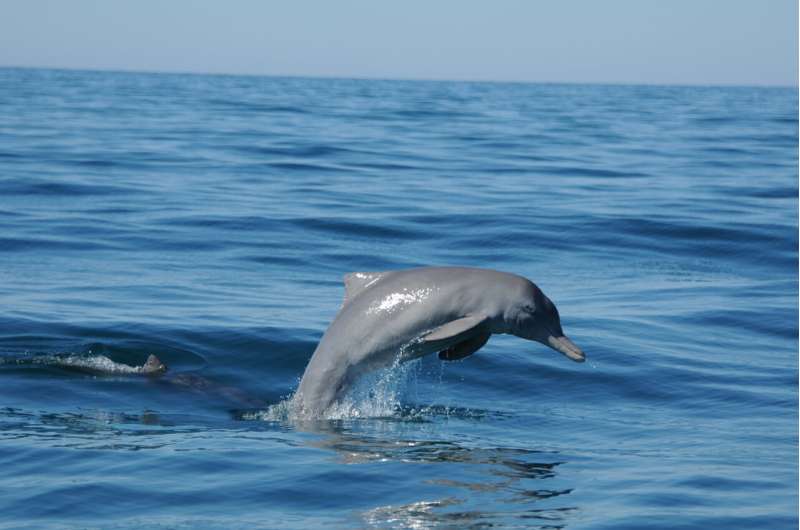This article has been reviewed according to Science X's editorial process and policies. Editors have highlighted the following attributes while ensuring the content's credibility:
fact-checked
peer-reviewed publication
trusted source
proofread
Diving into the secret life of mixed-species dolphin groups in Australia

In-depth research of two of Australia's dolphin species shows how their behaviors have evolved to co-exist and form mixed-species groups in northwestern Australia.
In the first extensive study of its kind, published in the journal Animal Behaviour, Flinders University researchers shed light on the intricate mechanisms facilitating the co-existence of two species of dolphins, the Australian humpback dolphin (Sousa sahulensis) and Indo-Pacific bottlenose dolphin (Tursiops aduncus).
Using detailed data collected over a six-year period around the North West Cape, WA, the research, led by Dr. Jonathan Syme and Associate Professor Guido J Parra from Flinders University's Cetacean Ecology, Behaviour, and Evolution Lab (CEBEL), harnessed behavioral focal follow data to study coexistence mechanisms and the functions of their mixed-species groups.
Flinders College of Science and Engineering Ph.D. Dr. Jonathan Syme says key findings from the study reveal distinct behavioral patterns between the humpback and bottlenose dolphins, indicating differences in resource utilization and behavior within the study area.
"Humpback dolphins were observed spending more time traveling, with higher transition probabilities towards traveling and longer bout lengths of traveling. Conversely, bottlenose dolphins exhibited more time spent foraging and longer foraging bouts.
"These behavioral patterns suggest that humpback and bottlenose dolphins utilize the study area differently, potentially minimizing direct competition and facilitating coexistence.
"Specifically, temporal differences in foraging behavior between the two species may contribute to their ability to share resources in the same habitat."
The study encompassed observations of both single-species and mixed-species groups of humpback and bottlenose dolphins. The primary aim was to investigate potential mechanisms facilitating behavioral coexistence and to discern the functions of mixed-species dolphin groups.
The study also investigated the behavior of mixed-species groups, revealing interesting insights into the social dynamics of these interactions.
When in mixed-species groups, both humpback and bottlenose dolphins exhibited altered behavioral patterns, displaying higher transition probabilities towards socializing and increasing time spent socializing.
Co-author and CEBEL director, Associate Professor Guido Parra, says the results emphasize the potential social benefits derived from mixed-species group formation.
"Mixed-species groups may serve a social function such as the practicing of socio-sexual behaviors, the provision of an ideal environment for the development of calves, and 'alloparental' care (when individuals who are not the biological parents of offspring help take care of them).
"The findings of this study not only contribute to our understanding of the coexistence dynamics of marine mammal communities but also the functions of their interspecific interactions," adds Associate Professor Parra, who supported the work with Assistant Professor Jeremy Kiszka, from Florida International University.
More information: Jonathan Syme et al, Behavioural variation facilitates coexistence and explains the functions of mixed-species groups of sympatric delphinids, Animal Behaviour (2024). DOI: 10.1016/j.anbehav.2024.01.016
Journal information: Animal Behaviour
Provided by Flinders University


















